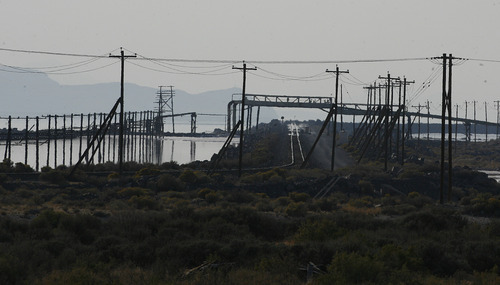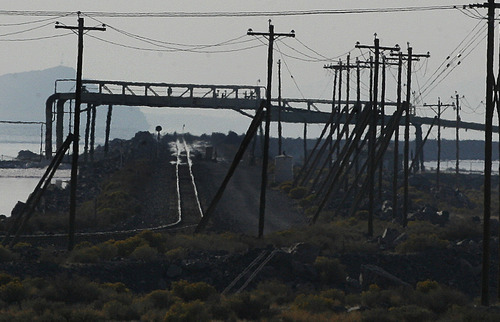This is an archived article that was published on sltrib.com in 2012, and information in the article may be outdated. It is provided only for personal research purposes and may not be reprinted.
An old railroad shortcut over the Great Salt Lake is triggering new controversy.
The rock and dirt causeway has sunk 20 feet in some places, and Union Pacific has asked for permission to plug two culverts and build a new bridge to address the problem. The U.S. Army Corps of Engineers has approved the railroad's request to fill the westernmost culvert right away because it is cracked and there is a danger a freight train could wind up in the lake.
But the federal agency added two conditions that the railroad has rejected: that UP develop plans to monitor the impact of the improvements and make sure salt circulates freely between the north and south arms of the lake.
Jason Gipson, chief of the Corps' Utah/Nevada Regulatory Branch, noted that his agency has the delicate job of balancing all of the uses of the lake, which has an estimated economic impact of $1.3 billion a year on the Utah economy, according to a recent study.
"There's so much going on on the lake," he said, pointing to salt and magnesium mining, migratory bird stopovers, brine shrimping and recreation. "It's dynamic."
And that's why his agency has been cautious with the railroad's request since it first came in early last year. Impairing the salt circulation could have a multimillion-dollar impact on others dependent on the lake.
The mitigation and monitoring plan, due Nov. 30, is intended to make sure that any harm done by changing the causeway can be promptly corrected, Gipson said.
More than a decade ago, the Utah Division of Forestry, Fire and State Lands began to worry the causeway — running between Promontory Point on the east side of the lake and Lakeside, on the west — morphed into a kind of dam, dividing the lake into two starkly different pieces.
Most of the fresh water entering the lake flows into the south arm, where salt levels dip below what's needed by brine shrimp. In contrast, the north arm has become like a giant evaporation pond where the water — without circulation from the fresher south arm — can become too salty for brine shrimp.
Three openings in the causeway allow for mixing: two square, concrete culverts and a 300-foot-wide breach the state opened in 1984 to improve water circulation. But divers for UP identified a crack in the west culvert earlier this year.
"It was in danger of collapsing on itself, especially with those heavy trains going over it," said Gipson.
While the Corps wants to address the immediate safety issue, it cannot abandon its concerns about the other users, he said, explaining why his agency approved the culvert repair request last month.
Dan Harbeke, spokesman for UP in Salt Lake City, said the company's repair plan takes care to preserve the circulation while making the 20-mile causeway safe for the 15 or so trains that use it every day. Yet, the company has rejected the Corps' requirements for mitigation and monitoring.
"We have a number of issues with that, and we've expressed those issues in a letter as recently as last week," Harbeke said.
He added that UP will exercise its option to deal with the culvert "under an emergency provision." The work will be done "sooner rather than later because this is an emergency situation," he said.
Since the application to work on the causeway is not generally a public process, most of the dialogue has been between the Corps, the company and state agencies with a stake in the issue, including Forestry, Fire and State Lands.
But that could change the longer the controversy continues.
"There are many issues that are affected, like salinity and water flow," said Jason Curry, a spokesman for the state lands office. "There are a lot of decision makers to weigh in on it."
The environmental advocacy group the Friends of the Great Salt Lake is watching the situation and hoping some good might come out of it, said Executive Director Lynn de Freitas.
Her hope is that the flap will lead to new opportunities to study the circulation issues and to learn more about the unique Great Salt Lake ecology.
"It's not just Friends [of the Great Salt Lake] that wants to do the right thing but everyone who works with the lake and understands the dynamics of the system," she said. "We are all looking for the best answer possible for the system and the users of the system."
Twitter: @judyfutah.com —
The causeway controversy
Union Pacific has an easement from the state to use the 20-mile east-west causeway connecting Promontory Point and Lakeside. This freight train shortcut is in danger because two small culverts are failing and one of them is already cracked. The U.S. Army Corps of Engineers has granted permission to make the emergency repair with two conditions that UP is resisting.





